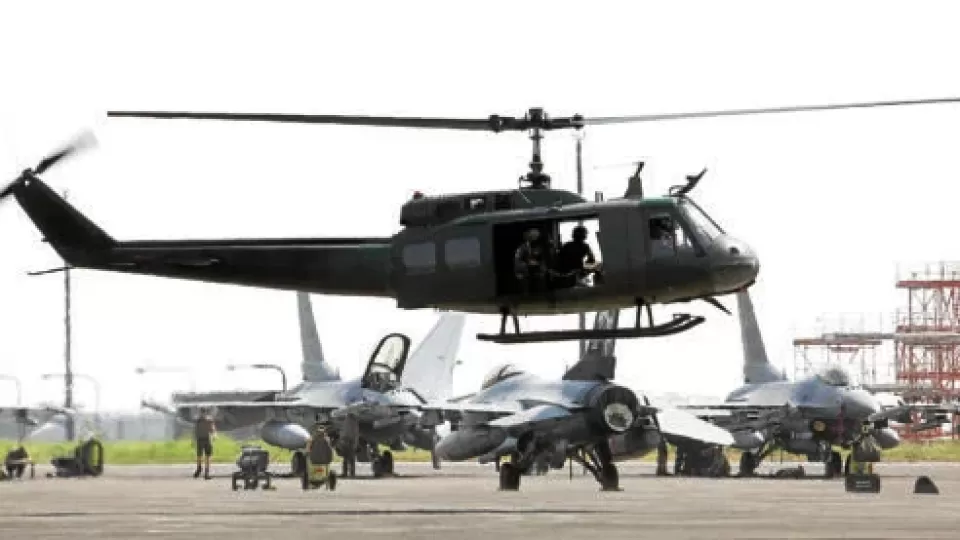May 10, 2023
MANILA – The Cope Thunder air combat exercises returned to Philippine skies on Tuesday for the first time in three decades, with US and Filipino fighter jets simulating engagements with an enemy force over the West Philippine Sea (WPS).
“They’re going to fight from over the water and look to gain ground and work toward the coastlines,” Cpt. Tank Martin of the Pacific Air Forces told reporters, explaining the day’s drills involving F-16 fighter jets of the US Air Force (USAF) soaring in pairs with FA-50 lead-in fighter trainers of the Philippine Air Force (PAF).
The PAF and USAF have been conducting a similar training in recent years, dubbed Bilateral Air Contingent Exercise, after the PAF returned to the supersonic age with the acquisition of interim FA-50 fighters from Korea Aerospace Industries in 2015.
The revived program was renamed Cope Thunder, in an apparent nod to the years when such exercises were framed in Cold War scenarios. This time, however, regional tensions arising from China’s aggressiveness in the WPS has underlined the need for such level of preparedness and “interoperability” between the militaries of the two treaty allies.
The training area located west of Luzon was designated by the Civil Aviation Authority of the Philippines as an “intensive military training area.’’
Officials maintained, however, that the location should not be construed as related to the current security situation.
Like ‘Top Gun’
Cpt. Ferdinand Carlos Jose of the PAF referenced a blockbuster Hollywood movie in describing Cope Thunder’s importance.
“They (US) are giving us high standards of training that they’ve got from the [Fighter] Weapons School, as known in the movie Top Gun,” he said. “They’re sharing what they’ve learned from high-level training facilities so it’s a very good opportunity for us.”
ADVERTISEMENT
Without such exercise, the PAF would be limited to training against its own aircraft. “But with this kind of exercise, we can simulate multiple threats and we can react as a coalition,” Jose added.
The F-16 jet fighter, built by US defense manufacturer Lockheed Martin, is one of the two shortlisted choices by the PAF for its planned acquisition of multi-role fighters. The other is SAAB’s Jas-39 Gripen from Sweden.
Ended with bases exit
Cope Thunder started in the Philippines in 1976 as a multinational exercise, but the training stopped after the US military closed its bases in Clark and Subic Bay in 1991 due to damage from the Mt. Pinatubo eruption that year and also after the Philippine Senate voted against extending the lease on US military facilities.
The exercise was then moved to Eielson Air Force Base in Alaska in 1992, and was eventually called Red Flag Alaska.
“Hopefully in the future our exercises will become multilateral again,” PAF spokesperson Col. Ma. Consuelo Castillo said.
The exercises are taking place shortly after Manila and Washington concluded in late April its largest ever “Balikatan” military exercise, which saw the participation of more than 17,000 troops.
They also followed the Philippines granting the US access to four more military bases under the Enhanced Defense Cooperation Agreement (Edca), bringing the total from five to nine. Edca allows the United States to preposition military assets on Philippine soil to respond to emergencies.
Two iterations
This year’s Cope Thunder will be held twice, with the first iteration set from May 1 to May 12, and the second scheduled from July 2 to July 21.
Around 400 PAF airmen and 160 USAF service members are currently taking part in the first round. Castillo said the next drills set for July would involve more aircraft.
“Besides fighter aircraft, there will be an involvement of cargo aircraft because we would need to simulate movement of a large fleet together with all the support equipment and support personnel,” Castillo added. “If there are certain regional security concerns that we have to respond to in tandem with other air forces, we need to move as a big fleet.”
During President Marcos’ visit to Washington last week, the United States announced it would hand over three more C-130 transport aircraft to the Philippines in support of the latter’s military modernization program. INQ


